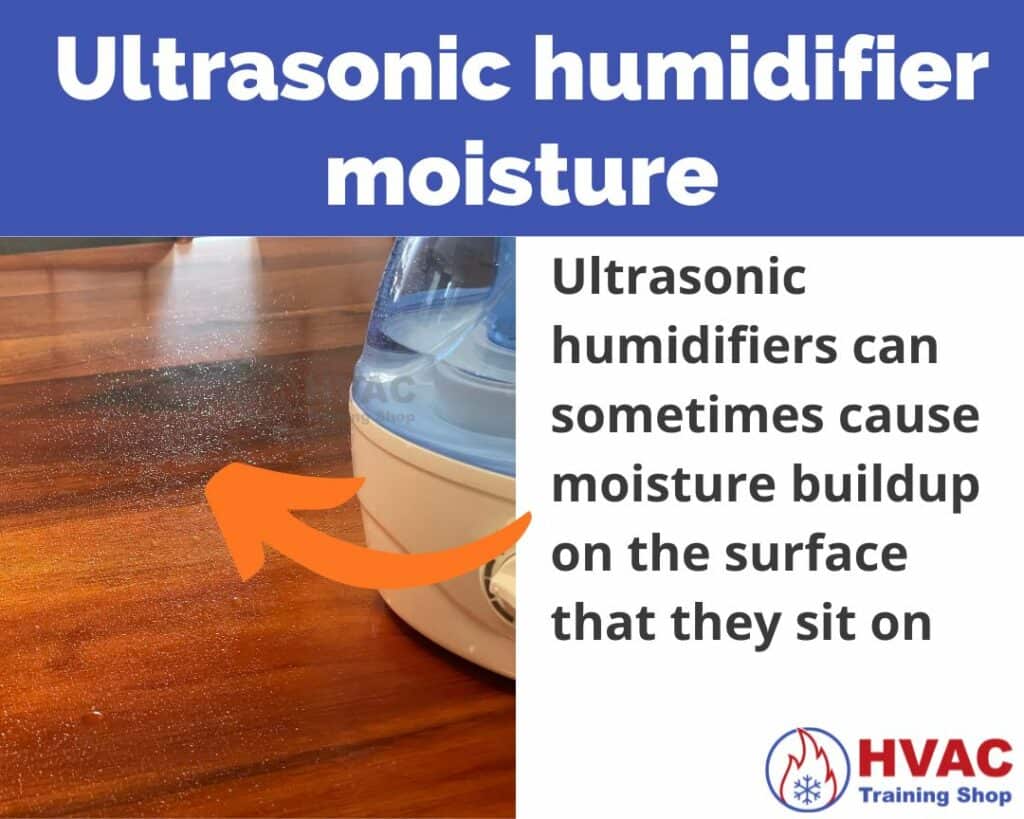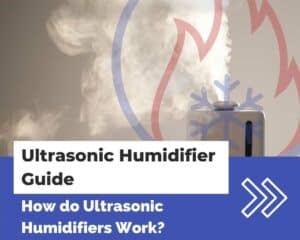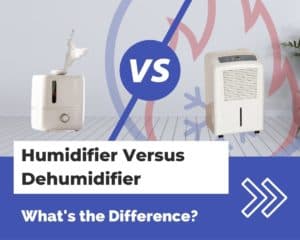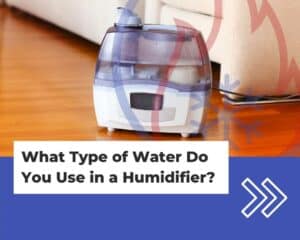HVAC Training Shop is reader-supported. As an Amazon Associate, I earn from qualifying purchases.
If you’re looking to increase the humidity in your home during the dry months, then a humidifier is the perfect device for doing so.
Most humidifiers can be placed into one of two categories: evaporative or ultrasonic.
In this article, I’ll go over the differences between evaporative and ultrasonic humidifiers—such as their working principles, health, safety, and operation concerns.
The difference between evaporative and ultrasonic humidifiers
Evaporative humidifiers work by blowing air through a saturated wet filter, while ultrasonic humidifiers work by vibrating a ceramic disc to create mist droplets.
I’ll go into more detail about how each humidifier works below.
How evaporative and ultrasonic humidifiers work
Evaporative humidifiers work by using a fan to move air through the unit. As the air moves through the evaporative humidifier, the air flows through a wicking filter that is saturated with water.
When the air passes through the filter, it picks up moisture from the filter and transfers the moisture to the air inside your room.
Ultrasonic humidifiers work by vibrating a ceramic disc to create mist droplets.
One or more ceramic discs are suspended inside a tank of water. The ceramic discs vibrate at ultra-high frequencies that cause the water to form mist particles that become suspended in the air.
A small fan blows these mist droplets out of the humidifier and into your room.
Once the mist droplets go into your room, they eventually evaporate into the air, raising the humidity inside the room.
Evaporative versus ultrasonic humidifier health and safety
Ultrasonic humidifiers create white “humidifier dust” that can be breathed in if you don’t use distilled water. Evaporative humidifiers don’t have this problem.
Evaporative humidifiers do not have many safety disadvantages, since they have no heating element and they include a filter to filter out minerals from your water.
The filtration will cut down on the amount of white “humidifier dust” accumulating on the surfaces inside your home.
In order to maintain the safety benefits of using an evaporative humidifier, you’ll want to ensure that you clean or change the filter regularly.
Ultrasonic humidifiers do not have a heating element so they don’t get hot. So there’s no risk of burns from using an ultrasonic humidifier.
Ultrasonic humidifiers are generally safe to place in an area where a child might be able to reach them.
Since ultrasonic humidifiers don’t have filters, the dissolved minerals that are present in tap water will go into the air that you breathe. This is what causes the “humidifier dust” that sometimes accumulates around your home when using an ultrasonic humidifier.
It is very important to only use distilled water in an ultrasonic humidifier. Distilled water has been treated to remove dissolved minerals.
If you use distilled water in your ultrasonic humidifier, you won’t get humidifier dust or mineral dust in your home’s air.
Evaporative versus ultrasonic humidifier mold and bacteria concerns
Ultrasonic humidifiers do not filter or heat water before vaporizing it, so mold and bacteria can enter its water droplets. Evaporative humidifier’s don’t have this problem.
If your ultrasonic humidifier is left uncleaned, mold and bacteria can enter the vaporized water droplets and eventually your home’s air. Be sure to clean your ultrasonic humidifier every 2-3 weeks to inhibit the growth of mold and bacteria.
Evaporative humidifiers don’t have as much of a problem with mold and bacteria. This is because they include a filter that helps to remove mold and bacteria from the water before adding moisture to the air.
No matter what kind of humidifier you end up getting, it is always important to clean your humidifier every 2-3 weeks for health, safety, and performance reasons.
Evaporative versus ultrasonic humidifier size and coverage area
Evaporative humidifiers are generally better for a large area since they use a fan to add humidity to a space, while ultrasonic humidifiers are better suites for smaller spaces.
The main factor in the size of a humidifier is the size of its tank. This means that a bigger tank = a bigger humidifier, no matter if it’s ultrasonic or evaporative.
With this in mind, you’ll want to select a humidifier according to the size of the room that you’ll be using it in.
For example, a small ultrasonic humidifier is suitable for use in a small space such as a bedroom since it doesn’t need to cover much area.
On the flip side, a large evaporative humidifier is more suitable for use in a large, open space such as a living room.
Generally, evaporative humidifiers are better suited for larger spaces since they use a fan to induce airflow through the humidifier unit.
This means that an evaporative humidifier will usually be able to use its fan to disperse moisture throughout a larger area.
A large 4-gallon tank makes this humidifier perfectly suited for large spaces such as living rooms. It also has a humidistat for precise humidity level control.
Evaporative versus ultrasonic humidifier noise
Ultrasonic humidifiers produce a slight high-pitched “humming” noise, while evaporative humidifiers generally emit more noise from the fan that blows air through the unit.
The humming sound from an ultrasonic humidifier is barely audible to most people. Chances are that you won’t even notice the slight hum from an ultrasonic humidifier.
However, people with sensitive hearing might get annoyed by the noise produced by an ultrasonic humidifier.
All evaporative humidifiers emit a considerable amount of noise from the fan that blows air through the unit.
The fan in an evaporative humidifier generally generates much more noise than an ultrasonic humidifier does. For this reason, light sleepers should stay away from using evaporative humidifiers in their bedrooms.
Evaporative versus ultrasonic humidifier pricing and operation costs
Generally, ultrasonic humidifiers have a larger upfront cost, while evaporative humidifiers have greater operating costs.
Ultrasonic humidifiers usually cost a little more to purchase. This is because their working principle is a more complicated and requires more parts to work.
However, once you own an ultrasonic humidifier, you won’t need to buy and replace any filters.
However, you’ll want to take into account the costs of using distilled water since most ultrasonic humidifiers require distilled water to work effectively.
Evaporative humidifiers are usually cheaper upfront. However, in order to keep your evaporative humidifier running safely and effectively, you’ll need to replace or clean the filter according to the manufacturer’s recommendations.
Generally, you should be replacing your evaporative humidifier’s filter every 1-3 months.
Air contaminants will reduce your humidifier filter’s lifespan. When your humidifier brings in air, it can pull in dust, smoke, and other air particles. These particles get trapped in the filter, and over time the filter will become embedded with particles that hinder its performance.
No matter if you have an ultrasonic or evaporative humidifier, you’ll want to empty out its tank and clean its parts every 1-2 weeks.
If your home is dusty, has pets, or has smoke, then you’ll want to clean your humidifier more often.
Evaporative versus ultrasonic humidifier moisture buildup
Ultrasonic humidifiers can sometimes cause moisture buildup on the surface that they sit on. Evaporative humidifiers do not have this problem.
The reason that this happens is that the ultrasonic humidifier’s mist particles do not have enough time to evaporate into the air.
After the mist is dispersed, it slowly falls down through the air and then rests on the surface around it, causing water droplets to build up.

To prevent moisture buildup, put your ultrasonic humidifier on a higher surface such as a shelf or countertop. Be sure that there is enough open space around your humidifier (especially the top) to allow the water droplets to properly disperse into the air surrounding it.
If you are seeing moisture buildup around your ultrasonic humidifier, this could also be an indication that there is not enough airflow in your room. Use a fan to circulate the air in your room to help prevent moisture buildup from happening.





